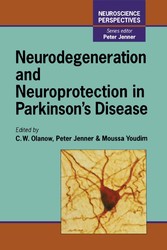Search and Find
Service
Front Cover
1
Neurodegeneration and Neuroprotection in Parkinson's Disease
4
Copyright Page
5
Contents
6
Contributors
10
Series Preface
12
Preface
14
Section 1: Oxidant Stress
16
Chapter 1. Oxidative stress, brain iron and neurodegeneration. Basic principles
16
1.1 Life in oxygen: a brief comment
17
1.2 The basic chemistry
17
1.3 Antioxidant protection
24
1.4 Brain iron and free radicals
26
1.5 Oxidative stress: the molecular targets
28
1.6 Oxidative stress in neurodegenerative diseases
30
1.7 Conclusions
32
Chapter 2. Pathological evidence for oxidative stress in Parkinson's disease and related degenerative disorders
38
2.1 Introduction
39
2.2 Alterations in iron in PD
40
2.3 Alterations in mitochondrial function
43
2.4 Alterations occurring in protective enzyme systems
45
2.5 Alterations in glutathione content
46
2.6 Oxidative damage in PD
48
2.7 Role of levodopa in alterations in indices of oxidative stress
49
2.8 Oxidative stress and incidental Lewy body disease
50
2.9 Other related studies
51
2.10 Which comes first? The horse or the cart?
52
2.11 Which free radical species are involved in PD?
53
2.12 Interrelationship of oxidant stress with other mechanisms of cell death
55
2.13 Conclusions
56
Chapter 3. Treatment of Parkinson's disease with deprenyl (selegiline) and other monoamine oxidase inhibitors
62
3.1 Introduction
62
3.2 Characteristics of MAOs
63
3.3 Development of MAO inhibitors
63
3.4 Deprenyl in PD
64
3.5 Basis for neuroprotective action
65
3.6 Clinical trials with MAO inhibitors in early PD
66
3.7 Neuroprotection versus symptomatic benefit
68
Chapter 4. Iron and neurodegeneration: prospects for neuroprotection
70
4.1 Introduction
70
4.2 Iron and the brain
72
4.3 Iron and neurodegeneration
73
4.4 Neuroprotection
79
Chapter 5. Nitrone radical traps protect in experimental neurodegenerative diseases
84
5.1 Introduction
85
5.2 Background
86
5.3 Recent experimental observations
94
5.4 Mechanisms of NRT protective action
99
Chapter 6. Therapeutic effects of nitric oxide synthase inhibition in neuronal injury
106
6.1 Introduction
106
6.2 Toxic effects of NO
108
6.3 NO in ischaemia
109
6.4 Neuronal NOS inhibitors
110
6.5 Cellular mechanisms of NO toxicity
112
6.6 Inducible NOS inhibitors
113
6.7 Conclusions
114
Section 2: Mitochondrial Toxicity
118
Chapter 7. Mitochondrial dysfunction in neurodegeneration: prospects for neuroprotection
118
7.1 Introduction
119
7.2 The mitochondrial respiratory chain and oxidative phosphorylation system
119
7.3 Diseases of the mitochondrial respiratory chain and mutations of mtDNA
125
7.4 Parkinson's disease
127
7.5 Complex I deficiency and the cause of PD
130
7.6 Mechanism of cell death in PD
132
7.7 Neuroprotective strategies
133
7.8 Neuroprotection and the cytotoxic theory
135
7.9 Conclusions
136
Section 3: Excitatory Neurotoxicity
140
Chapter 8. Bioenergetics and excitotoxicity: the weak excitotoxic hypothesis
140
8.1 Introduction
140
8.2 Neuronal energy metabolism
142
8.3 Metabolic impairment and neurodegenerative disease
144
8.4 Excitotoxicity and neurodegenerative disease
147
8.5 The weak excitotoxic hypothesis
148
8.6 Conclusions
154
Section 4: Calcium Excitatory Toxicity
158
Chapter 9. Calciumions in necrotic and apoptotic cell death
158
9.1 Introduction
158
9.2 Intracellular Ca 2+ homeostasis and signalling
159
9.3 Interference with cell signalling
160
9.4 Effects of cellular Ca 2+ overload
161
9.5 Role of Ca 2+ in apoptotic cell killing
164
9.6 Ca 2+ overload in neuronal cell death
166
9.7 Concluding remarks
170
Section 5: Trophic Factors
174
Chapter 10. Neurotrophic factors: towards a restorative therapy of Parkinson's disease
174
10.1 Introduction
175
10.2 Neurotrophic factors
177
10.3 Neurotrophic factors and dopaminergic systems
182
10.4 Neurotrophic factors and non-dopaminergic systems that degenerate in PD
188
10.5 The challenge of delivering protein growth factors to the brain
189
10.6 Transplantation and trophic factors in PD
191
10.7 Conclusion and future directions
194
Section 6: Immune Mechanisms
202
Chapter 11. Immune-mediated cell death and neuroprotection in neurodegenerative diseases
202
11.1 Introduction
202
11.2 Amyotrophic lateral sclerosis
204
11.3 Neurotrophic factors as neuroprotective agents
213
11.4 Parkinson's disease
214
11.5 Neuroprotective action of neurotophic factors
218
Section 7: Apoptosis
224
Chapter 12. Reduction of neuronal apoptosis by small molecules: promise for new approaches to neurological therapy
224
12.1 Nerve cell death and nervous system disorders
224
12.2 Trophic and trophic-like agents and neuronal apoptosis
227
Index
236
All prices incl. VAT











